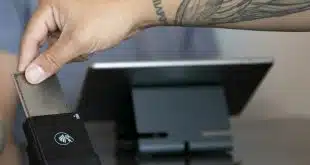Can anything beat rewards as an inducement to get consumers to use mobile payments? Some experts say apps that let you skip the line might just do the trick.
Mobile wallets are still relatively new technology, but the payments business has had enough experience with them to come to at least one conclusion: the payment function by itself isn’t enough to spark usage. Now the discussion has moved on to what features can do that.
For most mobile-wallet managers, rewards usually top the list, particularly the ability to apply discounts, points, and other loyalty loot right at checkout. But another benefit is climbing the hit parade: the ability to place an order, pay for it, and pick it up later without any waiting.
It’s called order ahead, and some experts see it becoming the number-one mobile-wallet benefit. “That’s something that’s going to explode,” says Leon Majors, a senior vice president at Phoenix Marketing International, a Rhinebeck, N.Y.-based research firm that polls consumers about mobile payments.
With order ahead, unlike rewards, you get the benefit every time. And that, say some, can build repeat store visits as well as regular usage of the payments app. “I’d say it’s probably more potent [than rewards] because it reinforces habits,” says Aaron McPherson, an independent payments analyst.
‘Making a Difference’
The allure of line-skipping, especially during crunch times at favorite cafes, isn’t lost on the fast-food crowd. Starbucks Corp. added order ahead to its hugely successful mobile-payments app in 2015, and now Mobile Order & Pay, which lets you customize your coffee down to the number of sugar cubes, accounts for 6% of all transactions, according to the company’s Nov. 3 earnings call.
At peak times, usage is even higher. In 3,300 stores, 10% of orders are coming through Mobile Order & Pay when the stores are busiest. In 600 stores at peak, order-ahead accounts for more than 20% of orders, three times the volume a year earlier. The mobile-payment app itself generates 25% of orders overall.
“Mobile Order & Pay is making a difference for both our partners and our customers,” Starbucks president Kevin R. Johnson said during the call.
Other fast-casual and fast-food chains are paying attention. Another early player was Taco Bell, and now other big-name brands like Panera, Chick-fil-A, and Dunkin’ Donuts have clambered onboard the order-ahead train.
“Once a customer has skipped the line, with the payment component essentially Uberized, they come to expect this from most major brands,” notes Jon Squire, founder and chief executive of San Francisco-based CardFree Inc., which develops mobile-payments apps for restaurants including Dunkin’.
Nor is order ahead confined to proprietary wallets offered by big-name chains. The trio of “Pays”—Android Pay, Apple Pay, and Samsung Pay—have wired the capability into their apps and “have plans to build that out further,” says Josh Gilbert, who follows the Pays at First Annapolis Consulting, an Annapolis, Md.-based firm.
Typically, the Pays work with third-party developers to build the order-ahead capability. And online delivery marketplaces are adopting the service, too. Android Pay, for example, works with Eat24, GrubHub, Open Table, and Seamless, among others.
‘A Running Start’
But the latest thrust has come from a bank wallet, and not just any bank wallet, but Chase Pay, the mobile-payments app launched late last year by JPMorgan Chase & Co.
When the money-center bank decided to recruit order-ahead capability for Chase Pay, it settled on Boston-based LevelUp, a 6-year-old mobile-payments startup that has already built links to 5,500 restaurant locations nationwide for payments, offers, and order-ahead capability, plus another 2,000 in Boston for order ahead only.
“Ordering ahead is, in our opinion, the best form of mobile payments,” says Alex Shuck, director of marketing and analytics at LevelUp.
The deal with LevelUp, announced in December, received plenty of publicity because it came just as Chase Pay had debuted for in-store payments at Best Buy and Starbucks and was looking for a way to penetrate the quick-service and fast-casual restaurant market, which accounts for millions of daily and weekly sales.
But there was more to the tie-up than a technology-sharing arrangement. Chase in September bought a stake in LevelUp for more than $10 million, linking the fate of the fledgling Chase Pay wallet even more closely to that of the startup, which has 1 million active users running $1 million each weekday through their smart phones at client eateries.
Observers say the investment could pay off handsomely for both companies. Launched in 2011 by what was then a 4-year-old mobile-game company called Scvngr Inc., the LevelUp mobile wallet can store national-brand cards and, like Chase Pay, links to point-of-sale scanners using quick-response codes.
This allows Chase to build scale by gaining access to LevelUp’s merchant base. The deal opens locations in Boston to Chase Pay immediately, with national availability rolling out over the coming months. “It took [LevelUp] years to put that acceptance footprint together, so Chase gets a running start at a key mobile-adoption sector,” says Steve Mott, principal at BetterBuyDesign, a Stamford, Conn.-based consultancy.
The deal also lets Chase leverage LevelUp’s order-ahead expertise. “Payment solutions, by themselves, are not compelling enough to move the needle for either the merchant or the consumer,” says CardFree’s Squire. “Chase seems to have recognized this and is looking to extend into more of the commerce-related solutions like order ahead.”
Meanwhile, what LevelUp gains from the tie-up, besides the cash infusion, is of course the bank’s national marketing power. But, more crucially, the deal brings to LevelUp clients the potential sales latent in the 90 million Visa accounts Chase has auto-loaded into Chase Pay. “We’re of course really excited about how the Chase Pay partnership will drive more customers to our merchant partners,” Shuck says.
‘One Payload’
Still, for all the enthusiasm for order ahead, other factors are moving, or could move, consumers to use mobile payments. In fact, in a survey Phoenix Marketing conducted last year, technical matters took a surprising pre-eminence. Some 35% said faster transaction times would get them to use mobile payments more often, while 30% said they’d use the wallets more frequently if only they could count on the terminals working properly with their phones every time.
Order ahead was cited by 22%, well below the 29% who mentioned that being able to apply rewards would get them going with mobile payments.
But Greg Weed, director of card research at Phoenix, says that number for order ahead has probably risen in recent weeks. The feature “is still pretty new,” he says. “Sometimes, it takes consumers a while to catch up and see how cool it is.”
Order ahead is also a complicated business for mobile developers and eating establishments alike. Even LevelUp relies on clients that have already built the feature or had it built for them. “Getting to scale with something as complex as menu management and order ahead is a challenge for all of us in the space,” says Squire.
Indeed, eateries often find themselves bringing in as many as half a dozen developers and suppliers to build mobile apps with a full range of features like payments, offers, loyalty, point-of-sale integration, customer-relationship management, and order ahead, Squire says. “The most common effect in the mobile-commerce endeavors of our partners is vendor fatigue,” Squire says.
CardFree, he adds, even has a patent pending for an integrated solution for this. “We’ve worked very hard to make any single scan, tap, and check-in via the cloud fire off all our services in one payload,” notes Squire.
‘The Hot Thing’
Nor have all order-ahead apps succeeded with consumers. One early example was Order, an app developed by Square Inc. as a replacement for its Square Wallet. After just 10 months, Square shut down Order in March 2015.
It was a rare product failure for the San Francisco-based processor, brought on by a scarcity of accepting merchants and a hefty 8% transaction fee. “What I remember is that there was no place near me where I could use it,” recalls Gilbert of First Annapolis.
But reaching and wiring in eateries for payments, offers, and order-ahead capability is only part of the puzzle. Aside from the technical complexity, order ahead can also be tripped up by all-too-human complications.
“A key value-add for mobile is the ability to jump the line,” says Mott. “That’s the theory. In practice, the barista is so busy they don’t actually get to the advanced orders often times.”
As Mott concedes, however, order ahead “is the hot thing.” It’s likely to filter down from the national and regional chains to smaller, one- and two-store diners, observers say, and quite possibly break into other merchant categories where line jumping would have consumer appeal.
McPherson, in fact, sees order ahead potentially enabling retailers to combat the increasingly firm hold online mega-merchants like Amazon.com Inc. have on consumers. “This thing could be a paradigm shift for retail,” he says. “I could see bookstores where you could order a book and run by and pick it up.”
That remains to be seen. But one thing is sure. Once consumers begin using a new payment method, they begin demanding more features. At one time, mobile payments were enough. Then rewards had to be added. Next, order ahead.
Now, order ahead is undergoing further refinement. Starbucks, for example, has already added to Mobile Order & Pay the ability to save favorite stores and favorite beverages, made to order. Coming up, said Johnson in that earnings call, are real-time product suggestions and the ability to save favorite orders.
Why this flurry of activity for order ahead? “We are enabling these digital experiences to bring joy to our customers while driving business outcomes,” Johnson said.
That may sound mundane, but few better summaries for the rationale behind order ahead have been spoken.





